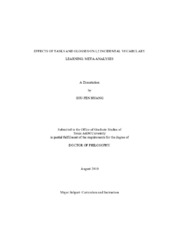| dc.contributor.advisor | Eslami, Zohreh R. | |
| dc.creator | Huang, Shu-Fen | |
| dc.date.accessioned | 2012-10-19T15:28:17Z | |
| dc.date.accessioned | 2012-10-22T18:06:39Z | |
| dc.date.available | 2012-10-19T15:28:17Z | |
| dc.date.available | 2012-10-22T18:06:39Z | |
| dc.date.created | 2010-08 | |
| dc.date.issued | 2012-10-19 | |
| dc.date.submitted | August 2010 | |
| dc.identifier.uri | https://hdl.handle.net/1969.1/ETD-TAMU-2010-08-8268 | |
| dc.description.abstract | This study investigated the effects of output stimulus tasks and glosses on L2 incidental vocabulary learning. Two meta-analytic studies were conducted. The first was intended to provide a systematic statistical synthesis of the effects of output stimulus tasks on L2 incidental vocabulary learning. A total of 12 studies were included in this meta-analysis. Results showed that language learners gained more benefit from using output stimulus tasks to learn vocabulary than those who only read a text. Results also supported the involvement load hypothesis that language learners who perform a task with a higher extent of involvement load gain more L2 vocabulary. As opposed to studies with the low level of design quality, studies with high and medium levels of design quality were more likely to detect statistically significant differences among groups with different output stimulus tasks. Moreover, results suggested that time on task had a positive impact on L2 vocabulary learning. Learners who read a combination of expository and narrative texts outperformed those who only read either an expository or a narrative text in the vocabulary posttest. Learners who read a text with text-target word ratios of less than or equal to 2 percent did not learn significantly more vocabulary than those who read a text with a ratio of 2 percent to 5 percent.
The second meta-analysis study used meta-analytic techniques to explore the effects of L1 textual and image-based glosses on second language (L2) incidental vocabulary learning while reading. Results revealed that language learners who were provided with textual glosses gained more vocabulary than those who had no access to glosses. Results suggested that text-target word ratios played an important role in second language vocabulary learning. Language learners who read a passage with a text-target word ratio of ≤2 percent outperformed those who read a passage with a text-target word ratio between 2 percent and 5 percent. No statistically significant difference was found between the groups that were provided with multiple-choice and single glosses. Compared to paper-and-pencil environments, computer-assisted settings did not significantly enhance L2 vocabulary learning. Language learners who read narrative reading materials did not significantly outperform those who were exposed to expository texts with regard to incidental vocabulary learning. No significant difference in L2 vocabulary learning was observed between groups who were given L1 textual glosses and those who had access to L1 textual image-based glosses. | en |
| dc.format.mimetype | application/pdf | |
| dc.language.iso | en_US | |
| dc.subject | Involvement load | en |
| dc.subject | glosses | en |
| dc.subject | vocabulary learning | en |
| dc.subject | meta-analysis | en |
| dc.title | Effects of Tasks and Glosses on L2 Incidental Vocabulary Learning: Meta-analyses | en |
| dc.type | Thesis | en |
| thesis.degree.department | Teaching, Learning, and Culture | en |
| thesis.degree.discipline | Curriculum and Instruction | en |
| thesis.degree.grantor | Texas A&M University | en |
| thesis.degree.name | Doctor of Philosophy | en |
| thesis.degree.level | Doctoral | en |
| dc.contributor.committeeMember | Willson, Victor | |
| dc.contributor.committeeMember | Burlbaw, Lynn M. | |
| dc.contributor.committeeMember | Hammer, Janet | |
| dc.type.genre | thesis | en |
| dc.type.material | text | en |


